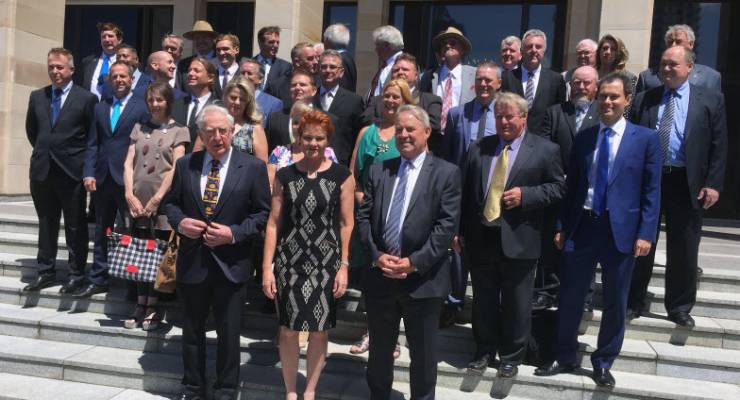
Two weeks on from the demolition of Colin Barnett’s government, the bill is now in for the fateful preference deal struck between the Liberals and One Nation.
This follows the finalisation of upper house counting on Friday and Saturday, from which the big news was One Nation’s shock win at the expense of a second Liberal member in the East Metropolitan region. As a result, One Nation emerges with exactly the outcome that was anticipated before all the talk turned to failure and disarray: three seats in the upper house, and a position of considerable influence in a chamber where Labor, and their natural allies in the Greens, don’t quite have the numbers.
In situations where One Nation refuses to play ball, the new government has two options for finding an 18th vote: a re-elected Shooters, Fishers and Farmers member, and Australia’s newest Glenn Druery-inspired accidental politician. The latter is one Aaron Stonehouse of the Liberal Democrats, a little-known 26-year-old call centre manager with an unusually light social media footprint.
Stonehouse was the beneficiary of a ballot paper placement in the South Metropolitan region that maximised the yield from confused Liberals (just as David Leyonhjelm had been when he was first elected to his New South Wales Senate seat in 2013). The rest of the work was done by preferences from five secular micro-parties, two religious ones, five independents, and One Nation candidates.
[Poll Bludger: making sense of the WA election result]
While the East Metropolitan boil-over has had One Nation claiming vindication, the oddity of Stonehouse’s election reinforces the point that it takes more than scattered upper house victories to pose an existential threat to the major party establishment.
Nonetheless, One Nation continues to hog headlines whether it wins, loses or draws — the latest example being Colin Barnett’s disputed claim that he had not been informed of the Liberals’ deal with the party in advance. Further clarity on the merits of the deal emerged when lower house preference counts were conducted last week, which suggested the flow of One Nation preferences to the Liberals was indeed higher than at the federal election last year — more like 60% than 50%.
But as Antony Green’s comparison of seats where One Nation did and didn’t run demonstrates, this was mostly a case of lost Liberal votes filtering back to where they came from, without achieving the real objective of a preference deal: gathering votes that might otherwise have strayed to the other side.
Whether as a result of voters’ independence of mind, or a lack of volunteers to distribute “how to vote” cards at polling booths, One Nation voters defied the party’s instructions in myriad ways. The Nationals were slightly favoured when they were competing with the Liberals, contrary to the directions of the card, and around a third of the preferences went to the Liberals despite the card instructing voters to do otherwise — as was the case where a popular independent was favoured in the seat of Baldivis.
In fact, it’s not even clear that the deal delivered One Nation any tangible benefit, even if the direct damage it did to their popularity is left out of the equation. One Nation achieved its wins in East Metropolitan and South West regions without Liberal preferences, and it’s a 50-50 proposition as to whether they were a decisive factor behind their win in the Mining and Pastoral region.
[Rundle: inside the One Nation campaign on the ground in WA]
Indeed, Liberal preferences actually deprived One Nation of a seat in the Agricultural region, where they had favoured the Shooters, Fishers and Farmers. Despite the washout from the deal, the Liberals have so far not committed to avoiding the same mistake at future federal and state elections. But in common with every other aspect of Pauline Hanson’s second act to this point, this one seems likely to go the same way as the first — with the Liberals repudiating the party and tackling the threat it poses head on.
As Labor’s campaign demonstrated, there are far more votes to be won through effective advocacy of the case against One Nation than there are through backroom preference shenanigans, for reasons to do with Hanson’s deficiencies as a politician.
Its been more than two decades since the circumstances of Hanson’s own life were an accurate match for her image as a suburban battler — a fact she seems to have lost sight of by investing too heavily in the cult of her own victimhood. Compounded by her long-established weakness for bad advice, this has resulted in Hanson promoting a hard-right economic agenda that has nothing to offer working-class voters beyond nationalism and hostility to privatisation.
But if a populist movement came along that was able to combine Hanson’s name recognition and media hype with a voice genuinely expressive of Australia’s neglected economic margins — how very different things might be.








“But if a populist movement came along that was able to combine Hanson’s name recognition and media hype with a voice genuinely expressive of Australia’s neglected economic margins — how very different things might be.”
Our Donald aka Clive Palmer seemed to understand this but lacked the integrity and determination to make a permanent mark on our political landscape.